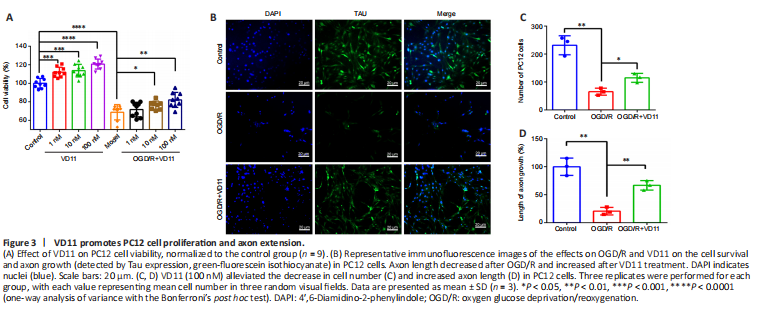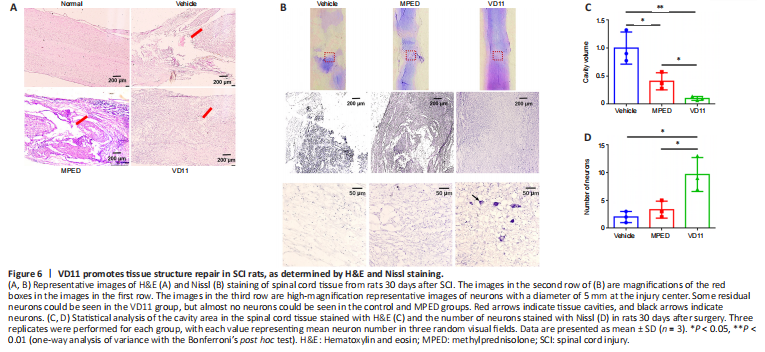脊髓损伤
-
Figure 3| VD11 promotes PC12 cell proliferation and axon extension.

PC12 cells stimulated with physiological NGF are commonly employed in in vitro studies of neurological illnesses (Wiatrak et al., 2020). To investigate the effects of VD11 on PC12 cells subjected to OGD/R, PC12 cell viability was assessed by 3-(4,5-dimethylthiazol-2-yl)-5-(3-carboxymethoxyphenyl)-2-(4-sulfophenyl)-2H-tetrazolium assay. Compared with the control group, cell viability was higher in the 1, 10, and 100 nM VD11 groups, respectively. Cell viability was lower in the OGD/R group compared with the control group, indicating that the model was successfully established. Compared with the OGD/R group, cell viability increased after treatment with 1, 10, and 100 nM VD11, respectively (Figure 3A). In addition, after OGD/R, PC12 cells showed a reduction in the number of cells and axon growth compared with the control group (Figure 3B), whereas treatment with VD11 rescued these effects.
The immunofluorescence staining results showed that, compared with normal cultured cells (the control group), both the number of cells and the axon length at 48 hours after OGD/R were markedly reduced (n = 3, P < 0.01 and n = 3, P < 0.01, respectively). However, compared with the OGD/R model group, the number of cells in the OGD/R + VD11 (100 nM) group was increased after 48 hours (n = 3, P < 0.05), and the axon length was increased as well (n = 3, P < 0.01). The increase in PC12 cell axon length after VD11 treatment may indicate that VD11 has a neuroprotective effect in the context of OGD/R (Figure 3B–D).
Figure 6|VD11 promotes tissue structure repair in SCI rats, as determined by H&E and Nissl staining.

To study the effect of VD11 on tissue repair in rats, spinal cords were analyzed 30 days after SCI. The presence of both ventral and dorsal scars on the spinal cord indicated successful transection (Figure 5A and B). Compared with the vehicle and MPED groups, the ventral and dorsal scar lengths in the VD11 group were much shorter (n = 3, P < 0.01 and n = 3, P < 0.05, respectively; Figure 5C and D). Thus, rats treated with VD11 exhibited less scar formation and improved spinal cord healing compared with rats treated with normal saline or MPED. H&E staining and Nissl staining also showed that VD11 reduced the area of the tissue defect (Figure 6A and B). Based on analysis of H&E-stained spinal cord tissue, the tissue cavity area was markedly decreased in the VD11 group compared with the vehicle (n = 3, P < 0.01) and MPED groups (n = 3, P < 0.05; Figure 6C). Nissl staining showed that the number of surviving neurons was significantly higher in the VD11 group (P < 0.01 and P < 0.05, respectively; Figure 6D) than in the vehicle and MPED groups. Thus, VD11 exhibited a strong neuroprotective effect post-SCI.
Figure 7|VD11 alleviates nerve injury and promotes nerve regeneration in SCI rats, as determined by immunofluorescence staining.

To assess nerve tissue damage and regeneration at the SCI sites in rats, GFAP and Tau were used for immunofluorescence labeling of astrocytes (Sullivan, 2014) and neuronal axons (Yu and Rasenick, 2006), respectively. As shown in Figure 7A, typical GFAP-positive astrocytes and Tau-positive neuronal axons were observed in the VD11 group within the lesion site 30 days after SCI, indicating alleviation of nerve injury and/or the occurrence of astrocyte regeneration and axon extension, and these effects were much more pronounced than in the vehicle and MPED groups. In particular, in the center of the lesion site there were large cavities, and almost no GFAP+ astrocytes and Tau+ axons were observed, in the vehicle and MPED groups. The GFAP+ content of the cavity area was significantly lower in the VD11 group (23.79 ± 8.90%) than in the vehicle (100.00 ± 12.82%, n = 3, P < 0.01) and MPED groups (47.16 ± 10.57, n = 3, P < 0.05). In addition, the Tau+ content of the cavity area was significantly lower in the VD11 group (11.38 ± 4.82%) than in the vehicle (100.00 ± 22.39%, n = 3, P < 0.01) and MPED groups (49.99 ± 10.25%, n = 3, P < 0.01) (Figure 7B and C). These results indicate that VD11 alleviated nerve injury and promoted nerve regeneration after SCI.